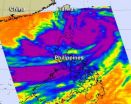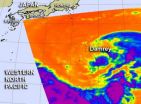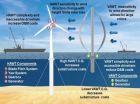(Press-News.org) Typhoon Saola looks like a monster tropical cyclone in infrared imagery from NASA's Aqua satellite today, July 30. Although Saola's center is over 300 nautical miles (368 miles/592 km) south-southeast of Taiwan, it stretches over the north and central Philippines and has triggered a number of warnings throughout the country.
The Moderate Resolution Imaging Spectroradiometer (MODIS) instrument on NASA's Terra satellite captured an image of Typhoon Saola approaching Taiwan on July 30 at 0215 UTC (July 29 at 10:15 p.m. EDT). The image showed a ragged eye in the storm's center and the huge extent of the storm's clouds, stretching southwest over the Philippines. For a high resolution, unlabeled MODIS image, visit: http://lance-modis.eosdis.nasa.gov/cgi-bin/imagery/single.cgi?image=Saola.A2012212.0215.500m.jpg.
NASA's Aqua satellite passed over Typhoon Saola a couple of hours after the Terra satellite. On July 30 at 0517 UTC (1:17 a.m. EDT) and the Atmospheric Infrared Sounder (AIRS) instrument onboard the Aqua satellite captured an infrared image of the storm. It showed that strong, high, cold cloud tops of thunderstorms extended from the center of circulation some 300 miles from Taiwan southwest over the Philippines. The eye of the storm appeared much clearer on the AIRS infrared imagery than on the visible MODIS imagery.
On July 30, the following warnings were posted in the Philippines: Public storm warning signal #1 is in effect for the following provinces of Luzon: Apayao, Isabela, and Kalinga. Public storm warning signal #2 is in effect for the Luzon province of Cagayan and the Babuyan and Calayan groups of islands. Public storm warning signal #3 is in effect for the Batanes group of islands.
Forecasters at the Joint Typhoon Warning Center expect Saola to continue on a northwesterly track taking the center just north of Taipei, Taiwan on Wednesday, August 2. That means strong winds, heavy rainfall, and very rough coastal conditions for Taiwan.
On July 30 at 1500 UTC (11 a.m. EDT) Saola had maximum sustained winds near 65 knots (75 mph/120.4 kmh). It was centered 320 nautical miles (368 miles/592.6 km) south-southeast of Taipei, Taiwan near 20.6 North and 124.6 East. Saola is moving slowly to the northwest at 5 knots (5.7 mph/9.2 kmh), meaning more rainfall for the Philippines and more potential for flooding.
The Joint Typhoon Warning Center expects Saola to continue intensifying over the next couple of days and will make landfall in mainland China sometime on Thursday, August 3.
INFORMATION:
NASA sees Typhoon Saola's huge reach over the Philippines
2012-07-31
ELSE PRESS RELEASES FROM THIS DATE:
NASA sees compact Tropical Storm Damrey approaching southern Japan
2012-07-31
Tropical Storm Damrey appears to be a compact tropical storm on NASA satellite imagery as it heads west. It is expected to pass north of Iwo To, Japan and later south of Kyushu, one of Japan's large islands.
NASA's Aqua satellite passed over Tropical Storm Damrey on July 30 at 03:21 UTC (July 29 at 11:21 p.m. EDT) and the Atmospheric Infrared Sounder (AIRS) instrument captured an infrared image of the storm. It showed that strong, high, cold cloud tops of thunderstorms were in a tight circle around the center of circulation. There were bands of thunderstorms mostly north ...
Mechanism of lung cancer-associated mutations suggests new therapeutic approaches
2012-07-31
Vanderbilt-Ingram Cancer Center researchers have identified how one of the genes most commonly mutated in lung cancer may promote such tumors.
The investigators found that the protein encoded by this gene, called EPHA3, normally inhibits tumor formation, and that loss or mutation of the gene – as often happens in lung cancer – diminishes this tumor-suppressive effect, potentially sparking the formation of lung cancer. The findings, published July 24 in the Journal of the National Cancer Institute, could offer direction for personalizing cancer treatments and development ...
Offshore use of vertical-axis wind turbines gets closer look
2012-07-31
ALBUQUERQUE, N.M. — Sandia National Laboratories' wind energy researchers are re-evaluating vertical axis wind turbines (VAWTs) to help solve some of the problems of generating energy from offshore breezes.
Though VAWTs have been around since the earliest days of wind energy research at Sandia and elsewhere, VAWT architecture could transform offshore wind technology.
The economics of offshore windpower are different from land-based turbines, due to installation and operational challenges. VAWTs offer three big advantages that could reduce the cost of wind energy: a ...
A closer look at the consuming gaze
2012-07-31
Montreal, July 30, 2012 – Rows of chip bags in a vending machine, endless bottles of shampoo on pharmacy shelves, long lines of books arranged in the bestsellers section at the bookstore. From supermarket shelves to barroom beer selection, long lines of horizontally arranged products are the norm when it comes to the shopping experience.
But how does where a product is placed on the storeroom shelf influence which option a consumer will ultimately choose? It turns out that the shopper's eye has a very central focus.
"Consumers are more likely to purchase products ...
Scientists probe link between magnetic polarity reversal and mantle processes
2012-07-31
Scientists at the University of Liverpool have discovered that variations in the long-term reversal rate of the Earth's magnetic field may be caused by changes in heat flow from the Earth's core into the base of the overlying mantle.
The Earth is made up of a solid inner core, surrounded by a liquid outer core, in turn covered by a thicker or more viscous mantle, and ultimately by the solid crust beneath our feet. The magnetic field is generated by the motions of the liquid iron alloy in the outer core, approximately 3,000 km beneath the Earth's crust. These motions ...
Study: Conciliatory tactics more effective than punishment in reducing terrorism
2012-07-31
WASHINGTON, DC, July 25, 2012 — Policies that reward abstinence from terrorism are more successful in reducing such acts of violence than tactics that aim to punish terrorists, suggests a new study in the August issue of the American Sociological Review.
Titled, "Moving Beyond Deterrence: The Effectiveness of Raising the Expected Utility of Abstaining from Terrorism in Israel," the study looked specifically at the Israeli-Palestinian conflict and found that between 1987 and 2004, Israeli policies and actions that encouraged and rewarded refrain from terrorist acts were ...
New influenza virus from seals highlights the risks of pandemic flu from animals
2012-07-31
A new strain of influenza virus found in harbor seals could represent a threat to wildlife and human health, according to the authors of a study appearing July 31 in mBio®, the online open-access journal of the American Society for Microbiology. It is crucial to monitor viruses like this one, which originated in birds and adapted to infect mammals, the authors say, so that scientists can better predict the emergence of new strains of influenza and prevent pandemics in the future.
"There is a concern that we have a new mammalian-transmissible virus to which humans haven't ...
EARTH: Trash-to-treasure
2012-07-31
Alexandria, VA – One man's trash is quickly becoming society's new treasure. In the August issue of EARTH Magazine, we explore how materials that were once considered garbage are now being recognized for their true potential as valuable energy resources capable of solving multiple problems at once. If successful, these "waste-to-energy" options could serve as a silver bullet – displacing fossil fuels, reducing greenhouse gas emissions, and decreasing the amount of trash that winds up in already teeming landfills.
Although several of these options have existed for many ...
To know a tiger is at least to start tolerating them, study shows
2012-07-31
To protect a dangerous and endangered animal -- be it a tiger in Nepal or a wolf in Michigan - you really do have to ask people "how do you FEEL about your predatory neighbor?"
Effective conservation calls for not only figuring out what protected species need – like habitat and food sources. It also requires an understanding of what it takes for their human neighbors to tolerate them. A Michigan State University doctoral student studying tigers in Nepal found that those feelings can provide critical information on how best to protect species.
"People have complex psychological ...
Rejected Alzheimer's drug shows new potential
2012-07-31
An international team of scientists led by researchers at Mount Sinai School Medicine have discovered that a drug that had previously yielded conflicting results in clinical trials for Alzheimer's disease effectively stopped the progression of memory deterioration and brain pathology in mouse models of early stage Alzheimer's disease. The findings, published July 31, 2012 in Molecular Psychiatry, demonstrate renewed potential for this compound and could lead to clinical trials in patients with early stages of the disease.
Latrepirdine, known commercially as Dimebon, was ...



